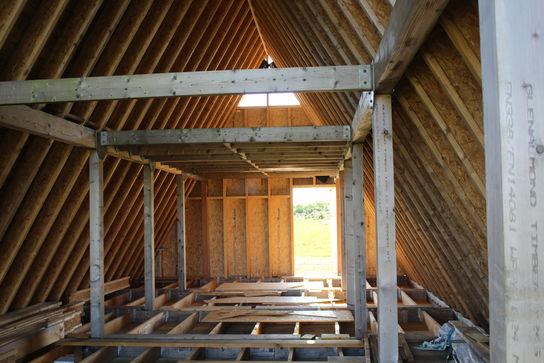-
Posts
1674 -
Joined
-
Last visited
-
Days Won
1
Ed Davies last won the day on October 10 2019
Ed Davies had the most liked content!
Personal Information
-
About Me
Currently building an off-grid timber-frame A-frame house on a windy hilltop in Caithness, Scotland. Slowly.
https://edavies.me.uk/blog/ -
Location
Caithness, Scotland
Recent Profile Visitors
The recent visitors block is disabled and is not being shown to other users.
Ed Davies's Achievements

Advanced Member (5/5)
485
Reputation
-

Is this one reason there is a permanent UK housing crisis...
Ed Davies replied to Bitpipe's topic in Housing Politics
Bye all. -
Let me rephrase that for you: “a ring final (also widely but incorrectly called a ring main)”, though why we don't just call them “rings” or “ring circuits”, as we do with radials, escapes me; a house will likely only contain final circuits and maybe the odd sub-main. PS: a “lighting ring” is almost never a ring. It's usually a branching radial.
-

Is this one reason there is a permanent UK housing crisis...
Ed Davies replied to Bitpipe's topic in Housing Politics
What are you talking about? I.e., which judge and what was the decree? -
5.7 MW? ITYM 5700W. Slightly less trivially, 1.37 kWh/day? That's an impressively small amount even with a decent size PV array assuming no battery, particularly with a 10 kW shower in the house. Are you sure that's right?
-
Talking about thick slabs is a bit tangential (sorry for the distraction) but mildly illuminating. Yes, the real control to make a wall thermostat work is that you don't heat the slab too hot. Fine with ASHP, perhaps, but might well be more awkward with, say, a non-modulating boiler (e.g. an oil boiler) unless you add a buffer tank as well or have a control system somewhat like @TerryE's where you count how many joules you're putting into the slab. Which brings us back to the @SteamyTea vs @Nickfromwales discussion: why might it be better to put higher-temperature water into a thin slab for controllability? I think we need to know more about the control system which @Nickfromwales has in mind if we're going to get anywhere. I'm having a hard time imagining one which would work better with hotter water rather than water just a few degrees over the desired slab temperature.
-
Agreed. The mechanical thermostat in my living room holds the temperature there to within about 0.25 °C. That's not the problem. With a thick slab, though, won't there be a possibility that too much heat will be dumped into the slab before the thermostat begins to see a rise in temperature resulting in an overshoot? Whether that's actually a problem in practice is a separate question but not one answered by your quoted experience.
-
Doesn't ring true to me, either. I'd think all floors, other things being equal, would need to take the same amount of heat long term but a low-heat-capacity one would benefit more from having lower-temperature water for more time. If he can present a plausible reason why that might not be so we can at least have a sensible discussion. That make sense as far as it goes. It doesn't follow that a basic mechanical room thermostat would work so well with a thick slab, though.
-
What would non-specific heat be? Or do you mean sensible heat? “Specific” in contexts like “specific heat capacity” means “per unit”, which can be taken to mean per unit mass unless otherwise, err, specified.
-
???? tank?
-
Equipment which is both IP67 and ELV (SELV, even) might not be allowed in either zone 0 or zone 1 depending on other conditions. E.g., an IP67 SELV light designed for outdoor use operating off 80 V DC or 30 V AC would not be allowed in zone 1 unless the manufacturer's instructions specifically said it was suitable for such use. All a bit irrelevant as the OP said they wanted to use a non-IP-rated light, anyway.
-
Discussion for the 17th edition but I don't believe anything relevant has changed for the 18th: https://www.youtube.com/watch?v=kYhUPjyAUas He's tediously repetitive but, in my limited experience, pretty solid and does go into why some of the wrong diagrams on the Internet exist.
-

Drying Washing Indoors
Ed Davies replied to Ferdinand's topic in General Self Build & DIY Discussion
At least they're on the correct feet. Other way round would annoy. Port and starboard. Select the white text if that makes no sense. -

The Walter Segal Method Of House Construction
Ed Davies replied to RichC's topic in New House & Self Build Design
Ah, right, I was assuming incorporated in the structure. Doing it again I'd have longer lengths, but thinner. E.g, instead of making up the purlins out of 3 metre or so long lengths of 145x245 C24 (or was it C16? I forget without looking - I do remember the posts were specced as C16 but I actually used C24 as that was what was available) I'd have used 3 off 6 or 7 metre lengths of 45x245 or whatever lengths of LVL staggered and bolted together. The ring beam for the floor has 13 metre lengths like that which I could move fairly easily with a bit of forethought. -

The Walter Segal Method Of House Construction
Ed Davies replied to RichC's topic in New House & Self Build Design
Hinging is sort of what I did. Still, specifically designing a hinge to be used once then sit unhinged for decades seems a bit odd.


